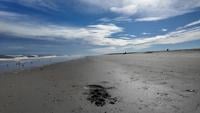ASSATEAGUE ISLAND, Va. -- The public beach will be moving 2.5 miles to the north. It's part of a larger-scale project that will include new trails, an access road and parking lots.
The project is fully funded and design work is 95% complete. Construction should get underway in March 2025 and wrap up in April 2026.
On the surface, the project might seem simple, but it's stirred up controversy among Chincoteague officials and neighbors who are happy with the Assateague they've come to know and love.
There aren't many beaches where you can park and be just a few steps away from getting your toes in the sand.
Chincoteague Councilmember Denise Bowden said the closest parking spot at the new beach will be at least 100 yards away.
"You're not going to get that beach experience there, especially when you're taking two or three kids, you got your coolers, you got your beach chairs, you know everything people take to the beach to enjoy for the day," said Bowden.
Part of Bowden's worries also stem from possible disruption to seashore species.
"I feel like, that the Fish and Wildlife Service is going to really destroy the habitat that they pledge to, you know, protect," said Bowden. "I'm just, I'm not a fan of it, never have been, never will be."
Bowden isn't alone in her environmental distress.
"It is very damaging to the environment," said Donna Leonard of Chincoteague. "They are putting a parking lot in a natural meadow, one of the very few that has not been manipulated."
Assateague Island National Seashore Superintendent Hugh Hawthorne told us on Thursday those concerns are legitimate, but his office along with the federal government have made sure this project is minimally invasive.
"We are probably impacting less than 10% of the wetlands area then was going to be impacted in the original version," said Hawthorne. "The impacts will not be zero, we understand that, but the impacts are as minimal as we could possibly design it."
Hawthorne also expects the environment to heal itself, so to speak.
"As the parking lot goes away naturally, the current parking lot, it will turn into an overwash area which is the prime area for breeding for the plovers and many other shorebirds," said Hawthorne.
The area might turn into a prime location for shorebirds, but Bowden said she's worried what will happen if the location isn't maintained.
"My concern there is that it's going to wash over and it's going to go into valuable shellfish grounds at Tom's Cove and not to mention, we're already having a problem right now with the inlet being so wide," said Bowden. "What's that going to do to the south end of Chincoteague? That's the problem I have right there."
At the end of the day, the environment is why this project is even happening. According to the US Fish and Wildlife Service and the National Park Service, the southern end of Assateague is migrating west 10 to 13 feet per year.
It's made the current location of the public beach more susceptible to storm damage and erosion. Since 2006, the beach has been engulfed by water from Tom's Cove and the Atlantic Ocean.
"There were 30 foot dunes there at one time, there was a restaurant, there were hard surface parking lots and all that stuff is out in the ocean now," said Chincoteague Mayor Arthur Leonard.
The slowly disappearing land is why the feds and Leonard see this project as a necessity, although Leonard noted it's not ideal.
"We've been working at this a long time, and it's better to have a plan in place rather than just saying 'okay, what we've got now is great, let's just not do anything'", said Leonard.
US Fish and Wildlife sent WBOC a statement regarding concerns over the project and touched on the research done that lead to this idea.
"The destruction of the recreational beach at its current location from storms and erosion is inevitable and will result in a devastating loss of visitors, jobs, and economic activity to the Town of Chincoteague and surrounding counties. Our goal is to implement a solution that is economically and environmentally sustainable — not to continue investing taxpayer dollars and resources to fight a losing battle. Since 2003, NPS and the Service have spent more than $15 million for storm recovery including as much as $400,000 per year in repeated maintenance costs.
The Service and NPS carefully considered substantial public input and comments over a multi-decade public planning and engagement process that informed our current strategy. We concluded that moving the beach to a more stable, climate resilient location north of the existing beach was the only available course of action that could conserve wildlife resources on the refuge, significantly reduce annual and long-term maintenance costs, and protect the viability of the local economy.
Over the last year, the Service and NPS staff have worked closely with Town of Chincoteague leadership and a contract engineering firm to complete a detailed design for new beach access facilities that will include a paved entrance road, paved multi-use bike path, gravel parking lots with around 1,000 spaces, and a series of beach access trails and a boardwalk.
Once the new beach facilities are completed and open to the public, we will manage the current beach area as natural beach, dune and saltmarsh habitats. We anticipate that working with nature will allow for the natural barrier island process to occur, creating habitat for threatened and at-risk bird species – including piping plover and saltmarsh sparrow – and offering protection to the local community from future storms."



